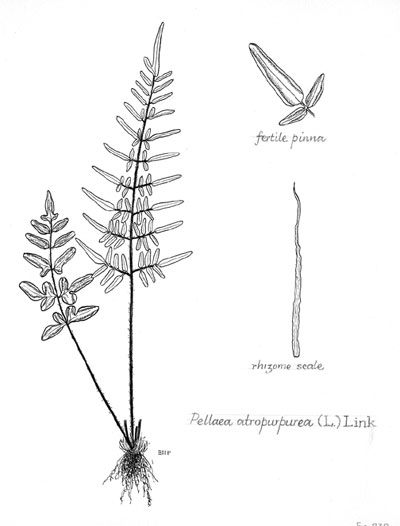|
Hardy Fern Home P. atropurpurea resources All Ferns � Pteridaceae �� Pellaea
�Other Genera
|
| Pellaea atropurpurea | ||
Purple cliff brake | ||
|
Etymology
Atro means dark, and purpurea means purple. See the description of the stipe.
Description
Rhizome: short-creeping, orange-brown scales.
Frond: 50 cm high by 18 cm wide, evergreen, somewhat dimorphic, sterile shorter and less divided than fertile fronds, blade/stipe ratio: 2:1. Stipe: dark purple to black, shiny, rounded above, scales uniformly reddish brown (or tan), linear, at base, vascular bundles: 1. Blade: usually 2-pinnate at the base, but sometimes more or less, elongate-deltate, leathery, rachis hairy, sparsely villous below near midrib of ultimate segments. Pinnae: 5 to 9 pair, bluish-green, lower pinnae stalked, upper sessile, a terminal pinna like the upper lateral ones; pinnules sessile or nearly so; veins obscure. Sori: oblong or linearly joined, submarginal, indusium: false, inrolled margins, sporangia: brown, maturity: early to late summer. Culture
Habitat: on calcareous rocks.
Distribution: Guatemala to northeastern North America to Florida.
Hardy to -30�C, USDA Zone 4.
Distinctive Characteristics
Similar to P. glabella, but differs in being taller, more upright, more divided, and particularly, the hairs on the rachis and costae.
Synonyms
Pteris atropurpurea Linnaeus Pellaea atropurpurea var. cristata Trelease |
|
|

Pellaea atropurpurea. Here the fertile frond is shown as shorter, a reversal of reality; perhaps the Bush Administration is in town. �Illustration by Edgar Paulton, from How to Know the Ferns and Fern Allies, John T. Mickel, � 1979 Wm. C. Brown Co. |

Pellaea atropurpurea. a) sterile and fertile fronds, b) fertile pinna. �Illustration by V. Fulford from Ferns and Fern Allies of Canada, William J. Cody and Donald M. Britton, 1989, � Agriculture Canada. |